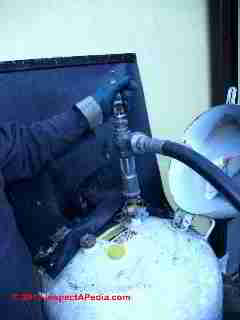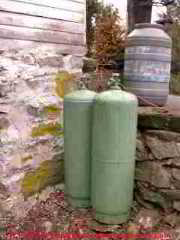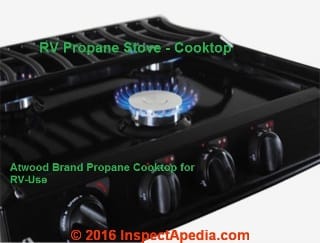 Propane Gas Exposure Effects
Propane Gas Exposure Effects
- POST a QUESTION or COMMENT about the toxicity of various gases found in buildings
Propane Gas - LP Gas Exposure Hazards & Dangers:
What are the effects on humans of exposure to LP or propane gases?
This article series gives basic information about exposure to and potential health hazards from a number of common toxic gases that may be found indoors or in or around buildings. We describe symptoms of exposure to these gases, industry recommendations for gas exposure limits, how gases may be measured, and how to track down and cure the sources of gas leaks in buildings.
InspectAPedia tolerates no conflicts of interest. We have no relationship with advertisers, products, or services discussed at this website.
- Daniel Friedman, Publisher/Editor/Author - See WHO ARE WE?
Propane Gas or LP Gas Exposure Hazards
 Watch out: if you smell propane gas indoors get everyone outdoors and call your propane gas supplier or call emergency services (911 in many locations). Propane at some concentrations is an explosion and fire hazard. Do not call from indoors, do not operate switches or anything else that might create a spark.
Watch out: if you smell propane gas indoors get everyone outdoors and call your propane gas supplier or call emergency services (911 in many locations). Propane at some concentrations is an explosion and fire hazard. Do not call from indoors, do not operate switches or anything else that might create a spark.
If you smell propane gas outdoors stay far away from the source of that smell and call your propane gas supplier or caLL emergency services.
What are the risks of exposure to propane gas?
The greatest LP gas or propane gas exposure risk other than fire or explosion, would be not the exposure to LP gas or propane gas itself but the prolonged absence of sufficient oxygen if someone is enclosed in a space with high concentration of propane.
No long term exposure health risks associated with LP gas or propane have been reported at low concentrations.
At air concentrations below 1000 ppm propane is virtually non-toxic. Brief exposures to 10,000 ppm cause no symptoms; 100,000 ppm can produce slight dizziness after a few minutes of exposure, but is not noticeably irritating to the nose and throat.
Propane is a simple asphyxiant. High concentrations of propane can displace oxygen and cause asphyxiation. Oxygen content in the atmosphere must not be allowed to fall below 18%.
Effects of oxygen deficiency are: 12-16% breathing and pulse rate increased, muscular co-ordination slightly disturbed; 10-14% emotional upset, abnormal fatigue, disturbed respiration; 6-10%: nausea and vomiting, collapse or loss of consciousness; below 6%: convulsive movements, possible respiratory collapse and death.
The gas does not affect the skin. Contact with liquified gas escaping from its high pressure cylinder may cause frostbite. Symptoms of mild frostbite include numbness, prickling and itching in the affected area.
Symptoms of more severe frostbite include a burning sensation and stiffness of the affected area. The skin may become waxy white or yellow. Blistering, tissue death and gangrene may also develop in severe cases.
Close range contact with liquefied propane gas may cause injury characteristic of a thermal burn with swelling, fluid accumulation and extreme redness. Tissue death and gangrene may also develop.
The gas does not cause eye irritation. Contact with liquified gas escaping from its high pressure cylinder may cause freezing of the eye. Permanent eye damage or blindness could result. - Canadian Centre for Occupational Health and Safety
In some areas propane gas and similar fuels may be referred to by the name of their distributor, such as "Cadac" gas referring to the blue fuel gas cylinders and related products sold in South Africa.
The symptoms of propane exposure depend on how you were exposed, the level of propane in the air you breathe, and the duration of that exposure. In general, if you inhaled propane gas, your symptoms will be due to oxygen deprivation.
Symptoms of Low Exposure Levels of Propane
Nausea
Dizziness
Headaches
Drowsiness
Coughing
Irregular heartbeat
Symptoms of Significant Exposure to Propane Causes
Pain or numbness in limbs
Convulsions
Diarrhea
Rapid loss of consciousness
Asphyxiation
Heart Failure - (propane.com 2022)
Propane PEL - Permissible Exposure Limit
The permissible exposure limit for propane, as given by California:
- CAS No 74896 - Propane
- PEL: 1000 ppm or 1800 mg/M3
- California Table of Permissible Limits for Chemical Contamianants, California Department of Industrial Relations, web: www.dir.ca.gov - retrieved 2022/11/11 original source: https://www.dir.ca.gov/title8/5155table_ac1.html
Question: is it OK to use a propane stove as a space heater in an RV?
Is it safe to use a propane stove as a primary source of heat inside an rv?
This question was posted orignally at GAS EXPOSURE EFFECTS, TOXIC
[Click to enlarge any image] Shown here, an Atwood brand propane-fueled cooktop for RVs.
Reply: NO, don't do it. Risk of fatal carbon monoxide poisoning
Sandi,
Watch out: No, definitely not. Never use an LP cooking appliance as a space heater in an RV nor in a mobile home. There are risks of both oxygen depletion and fatal carbon monoxide poisoning. If you fall asleep inside of your RV with your propane stove heating away you may never wake up. And in any event your RV should have properly-located and installed carbon monoxide detectors and smoke detectors. "
Almost 15 percent of [non-fire carbon monoxide poisoning deaths in the U.S. between 1993 and 1997 occurred ] in temporary shelters, such as cabins, recreational vehicles
or campers, tents, or trailers. (Mah 2000 for the US CPSC)
Also see CARBON MONOXIDE - CO
Watch Out: improper installation and even improper inspection and testing methods involving natural or "LP" gas can involve dangerous conditions and risk fire or explosion.
If you smell gas you should leave the building immediately and should do so without doing anything that could create a spark such as operating a light switch or telephone.
From a safe location, call your gas company's emergency line and/or your fire department.
Atwood, a manufacturer of LP fueled ranges and cooktops for RVs includes these warnings in its cooktop manual:
WARNING: CARBON MONOXIDE POISONING
DO NOT use cooking appliance for space heating. It is a potential danger to occupants of vehicle and damage to operating components of the range/cooktop.
A window or air vent should be open slightly while using any cooking appliance. Gas flames consume oxygen which must be replaced to assure proper combustion. (Atwood, 2016 cited below)
See the last sentence of the abstract from Liu (2000) for an example. Similar safety concerns in mobile homes were discussed by Frey as early as 1973
Research on Propane & LP Gas Hazards including in RVs & Mobile Homes
- Atwood LP Gas Range & Slide-in Cooktops, RV, CV, RA, CA (34) Models [PDF] Atwood, RV Ranges and Cooktops, 1120 N. Main St. Elkhart, IN 46514 Tel (USA) 800-546-8759 or Canada & USA: 800-825-4328, image & text excerpts adapted from http://www.askforatwood.com/ranges-and-cooktops.asp and from http://www.askforatwood.com/manuals/cooking/MPD%2051381%20SP%201.16.08.pdf retrieved 2016/12/02
- CCOHS, PROPANE FACT SHEET [PDF] Properties of propane, Canadian Centre for Occupational Health & Safety, CCOHS, - retrieved 2022/11/11 original source: https://www.ccohs.ca/oshanswers/chemicals/chem_profiles/propane.html
- Frey Jr, Louis, and J. Richard Knop. "Imperative Need for Uniform Mobile Home Safety Standards, The." Wash. & Lee L. Rev. 30 (1973): 459.
- Hall, John Raymond. Burns, Toxic Gases and Other Fire-like Hazards in Non-fire Situations. Quincy, MA: National Fire Protection Association, 2004.
- Liu, Kai-Shen, Maria Katrina Paz, Peter Flessel, Jed Waldman, and John Girman. "Unintentional carbon monoxide deaths in California from residential and other nonvehicular sources." Archives of Environmental Health: An International Journal 55, no. 6 (2000): 375-381.
Abstract:
To investigate risk factors of unintentional carbon monoxide deaths in California from nonvehicular sources, we identified 270 deaths resulting from nonvehicular sources of carbon monoxide poisoning from death certificates and coroners' investigation reports.
Data recorded between 1979 and 1988 in the state of California on risk factors and carbon monoxide sources were abstracted from investigation reports. We also used census and state statistics to calculate rates and relative risks. The highest rates, which occurred in winter, were found among males, African Americans, and the elderly. Relative risks (in parentheses) were higher among individuals who
(a) lived in multiunit dwellings (2.1),
(b) dwelled in mobile/trailer homes (4.7), and
(c) resided in temporary shelters (30.0) than among individuals who lived in single-family houses (1.0).
Unvented combustion heating appliances and charcoal fuel were associated significantly with the risks of fatal unintentional carbon monoxide poisoning. - Mah, Jean C. Non-Fire Carbon Monoxide Deaths and Injuries Associated with the Use of Consumer Products Annual Estimates [PDF] US Consumer Product Safety Commission, Bethesda, MD (2000).
- NJ DOH, PROPANE HAZARDOUS SUBSTANCE FACT SHEET [PDF] New Jersey Department ofHealth - retrieved 2022/11/11, original source: https://nj.gov/health/eoh/rtkweb/documents/fs/1594.pdf
Excerpts:
ODOR THRESHOLD = 20,000 ppm
Odor thresholds vary greatly.
Do not rely on odor alone to determine potentially hazardous exposures. - Propane PERC Propane Toxicity, Poisoning Symptoms, and How to Avoid Exposure [PDF] - retrieved 2022/11/11 original source: https://propane.com/staying-safe-around-propane-fumes/
- QEPA, SCIENTIFIC ANALYSIS & HEALTH IMPACT of PROPANE LEVELS in AMBIENT AIR, ERIE COLORADO [PDF] (2012) NOAA Earth System Research Laboratory, prepared by Quality Environmental Professional Associates - retrieved 2022/11/11, original source: https://www.erieco.gov/DocumentCenter/View/2513/Scientific-Analysis-and-Health-Impact-of-Propane-Levels-Final
- Smoot, E. Clyde, and William L. Hickerson. "Propane gas dangers and strategies for prevention of injuries." Journal of Burn Care & Research 17, no. 3 (1996): 273-279.
Abstract:
Although the overall incidence of thermal injuries continues to decrease, the incidence of certain types of burns is alarmingly high. Approximately 3000 propane fires and explosions are reported yearly.
More than 9% of these cases result in bodily injury, and the mortality rate is more than 7% of the injured.
Most of the accidents are felt to be the result of a lack of knowledge among the general public in regard to die use of liquid petroleum (LP) gas, which is a low-cost and widely used fuel source.
A series of accidents that resulted in several injuries in the midsouth area heightened our awareness of the problems associated with LP-gas storage, transportation, and use.
A review of [the] incidence of use and injury, warning systems, product liability status, and prevention strategies are reported to help educate health care providers and increase public awareness of the problems associated with propane gas. - US EPA, PROPANE ACUTE EXPOSURE GUIDELINE LEVELS [PDF] U.S. Environmental Protection Agency - retrieved 2022/11/11 original source: https://www.epa.gov/sites/default/files/2014-09/documents/propane_volume12_0.pdf - this is an excerpt from the original that includes exposure levels of BUTANE, CHLOROACETALDEHYDE, CHLOROBENZENE, CHLOROFORM, METHYL BROMIDE, METHYL CHLORIDE, and PROPANE
Excerpt:
Propane is a colorless and odorless gas. It is poorly soluble in water. The lower explosive limit is 2.3%.
Propane is an important constituent of liquefied petroleum gas and sometimes the main compound in liquefied petroleum gas used as (bus) fuel. It is a byproduct from various refinery processes.
Its main use is in the synthesis of chemicals, such as ethylene and propylene. It is also used as an aerosol propellant and as a refrigerant. Because it is easily accessible, propane is often used in inhalant abuse and in suicide attempts.
The toxicity of propane is low, so very high concentrations can be assumed in propane abuse. The predominant effects observed in such cases are effects on the upper and lower airways of the respiratory tract and on the brain.
Quantitative human data include an old study on the warning properties of propane and a study involving propane at low concentrations.
Toxicity and mortality data are sparse. Cardiac sensitization has been studied mainly in dogs and one study provides good quantitative data. Only an old study with guinea pigs focused on CNS depression. Propane was negative in the bacterial reverse mutation assay (Ames test). Carcinogenicity and reproductive toxicity studies are lacking.
The AEGL-1 values are based on a study of the warning properties of propane (Patty and Yant 1929). No effects were noted during a 10-min exposure to propane at 10,000 ppm, but distinct vertigo was reported by volunteers exposed at 100,000 ppm for 2 min. - US NLM PROPANE POISONING [PDF] Medline Plus, National Library of Medicine, retrieved 2022/11/11 original source: https://medlineplus.gov/ency/article/002836.htm
...
Continue reading at GAS EXPOSURE EFFECTS, TOXIC or select a topic from the closely-related articles below, or see the complete ARTICLE INDEX.
Or see these
Recommended Articles
- GAS EXPOSURE LIMITS & STANDARDS
- GAS EXPOSURE SCREENING TEST
- LPG & PROPANE APPLIANCE PRESSURES
- LPG PROPANE TANK PRESSURES
- LP / PROPANE GAS TANKS
Suggested citation for this web page
PROPANE GAS EXPOSURE EFFECTS at InspectApedia.com - online encyclopedia of building & environmental inspection, testing, diagnosis, repair, & problem prevention advice.
Or see this
INDEX to RELATED ARTICLES: ARTICLE INDEX to GAS HAZARDS in BUILDINGS
Or use the SEARCH BOX found below to Ask a Question or Search InspectApedia
Ask a Question or Search InspectApedia
Try the search box just below, or if you prefer, post a question or comment in the Comments box below and we will respond promptly.
Search the InspectApedia website
Note: appearance of your Comment below may be delayed: if your comment contains an image, photograph, web link, or text that looks to the software as if it might be a web link, your posting will appear after it has been approved by a moderator. Apologies for the delay.
Only one image can be added per comment but you can post as many comments, and therefore images, as you like.
You will not receive a notification when a response to your question has been posted.
Please bookmark this page to make it easy for you to check back for our response.
IF above you see "Comment Form is loading comments..." then COMMENT BOX - countable.ca / bawkbox.com IS NOT WORKING.
In any case you are welcome to send an email directly to us at InspectApedia.com at editor@inspectApedia.com
We'll reply to you directly. Please help us help you by noting, in your email, the URL of the InspectApedia page where you wanted to comment.
Citations & References
In addition to any citations in the article above, a full list is available on request.
- U.S. Army Field Manual FM-8-285-Noxious_Chemicals discusses Ammonia, Carbon Monoxide, Hydrogen Sulfide, Oxides of Nitrogen, Hazards caused by fire,
- [1] CADAC, Commercial And Domestic Appliance Company, produces a range of gas and camping products. we are guessing that typically they'd be marketing LP - liquid propane. Web search 07/22/2010 - original source: http://www.cadac.co.za/index.php?page=company describes Cadac products. their tel: support line on 0860 22 3 22 0
- [2] Canadian Centre for Occupational Health and Safety, web search 07/22/2010, original source: http://www.ccohs.ca/oshanswers/chemicals/chem_profiles/propane/health_pro.html
- [3] "Residential Electric Water Heater Installation Instructions and Use & Care Guide", American Water Heater Co., October 2001, American Water Heater Co., Johnson City, TN, [manufacturer of residential & commercial water heaters, also manufacturer of Polaris/Commercial water heaters], Tel: 800-999-9515, web search 1/12/2012, original source: americanwaterheater.com/support/manuals/res-elect.pdf [copy on file]
- [4] Portions of this data were extract5ed from CompuServe's SAFETYNET forum 1989 and from the following articles:
- Our recommended books about building & mechanical systems design, inspection, problem diagnosis, and repair, and about indoor environment and IAQ testing, diagnosis, and cleanup are at the InspectAPedia Bookstore. Also see our Book Reviews - InspectAPedia.
- ENVIRONMENTAL HEALTH & INVESTIGATION BIBLIOGRAPHY - our technical library on indoor air quality inspection, testing, laboratory procedures, forensic microscopy, etc.
CONTINUE READING or RECOMMENDED ARTICLES.
- Carson, Dunlop & Associates Ltd., 120 Carlton Street Suite 407, Toronto ON M5A 4K2. Tel: (416) 964-9415 1-800-268-7070 Email: info@carsondunlop.com. Alan Carson is a past president of ASHI, the American Society of Home Inspectors.
Thanks to Alan Carson and Bob Dunlop, for permission for InspectAPedia to use text excerpts from The HOME REFERENCE BOOK - the Encyclopedia of Homes and to use illustrations from The ILLUSTRATED HOME .
Carson Dunlop Associates provides extensive home inspection education and report writing material. In gratitude we provide links to tsome Carson Dunlop Associates products and services.


